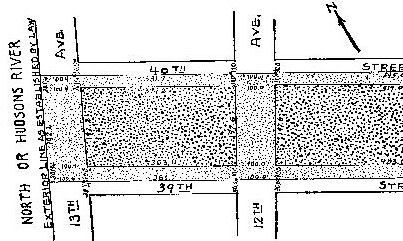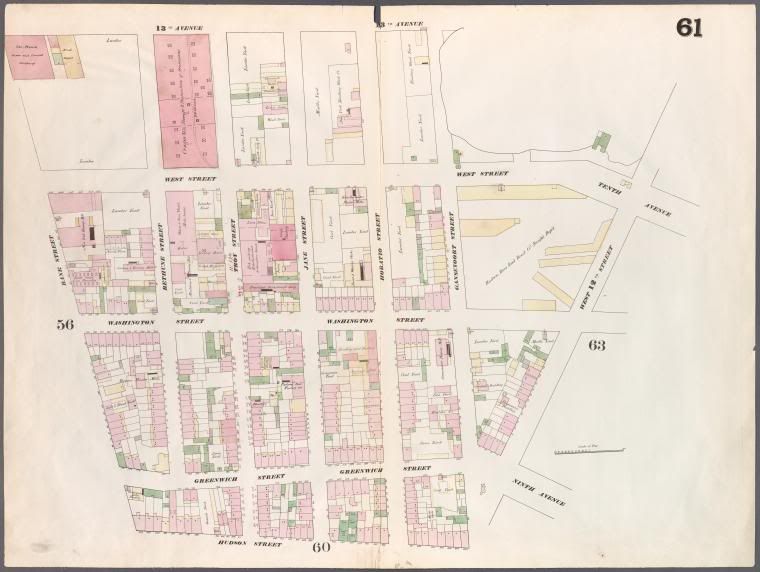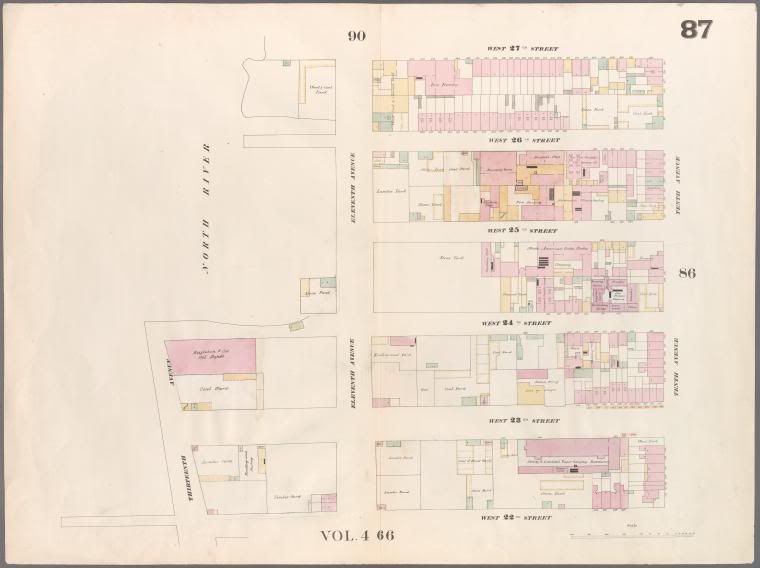Thirteenth Avenue
 Once upon a time, there was a Thirteenth Avenue in Manhattan.
Once upon a time, there was a Thirteenth Avenue in Manhattan.In 1837, the New York State Legislature passed a bill permitting the City of New York to extend the island's western shore further out into the Hudson River. The boundary of this westward extension was an imaginary line in the middle of the Hudson River that ran from Hammond Street (today, West 11th Street) to West 135th Street. Although this area was still under water, the imaginary line was designated as Thirteenth Avenue. The City then began vigorously selling the underwater lots to individuals, who promised to develop and landfill the lots.
Within eighteen years, Thirteenth Avenue was effectively destroyed when the state Legislature made it illegal to landfill beyond 100 feet of Twelfth Avenue -- in most places, well short of the original line designated for Thirteenth Avenue. This halted most development encouraged by the City until then, and even required sections already developed to be submerged. The advent of the age of the luxury liner required a wider corridor in the Hudson River if these ships were to dock in New York harbor. However, the Legislature's mandate left insufficient docking space for these increasingly imposing ships, such as the RMS Lusitania and the RMS Titanic. Therefore, in 1890, the Harbor Commission and the Secretary of War partially overrode the Legislature's decision by providing for an additional 50 feet beyond Twelfth Avenue, allowing space for what would eventually become the Chelsea Piers. Essentially, Thirteenth Avenue had to cede to the City's ever-constant desire to be one of the world's greatest ports.
One casualty of this decision was Charles Appleby, who bought the lot bounded by 39th and 40th Streets, and 12th and 13th Avenues, from the City in 1853 for $6,367.37 (today, approximately $141,000). Appleby's deed promised he would develop his lot pursuant to the City's instructions.
 Between 1853 and 1871, Appleby managed to landfill nearly 500 feet out to the Thirteenth Avenue line, and pave the street areas contained within his lot. However, when the laws changed regarding Thirteenth Avenue, the Secretary of War tried to condemn Appleby's lot. Meanwhile, the City -- in deep debt -- built piers adjacent to Appleby's lot, began dredging Appleby's lot up to depths of 20 feet, rented out mooring space over his land, and then sent him a bill for back taxes of $74,000 (today, approximately $1.25 million)! Appleby sued to prevent the City from dredging and using his lots, but the City seemed to think that public rights had somehow been re-acquired after all the legislative action regarding Thirteenth Avenue. Thirty-five years later, well after Appleby's death, the United States Supreme Court ruled in his favor and kicked the trespassing City off of his land.
Between 1853 and 1871, Appleby managed to landfill nearly 500 feet out to the Thirteenth Avenue line, and pave the street areas contained within his lot. However, when the laws changed regarding Thirteenth Avenue, the Secretary of War tried to condemn Appleby's lot. Meanwhile, the City -- in deep debt -- built piers adjacent to Appleby's lot, began dredging Appleby's lot up to depths of 20 feet, rented out mooring space over his land, and then sent him a bill for back taxes of $74,000 (today, approximately $1.25 million)! Appleby sued to prevent the City from dredging and using his lots, but the City seemed to think that public rights had somehow been re-acquired after all the legislative action regarding Thirteenth Avenue. Thirty-five years later, well after Appleby's death, the United States Supreme Court ruled in his favor and kicked the trespassing City off of his land.In 1883, The New York Times took its readers on a stroll up this "very peculiar avenue" of only about a dozen blocks, concluding that this was "a west side thoroughfare of little account."
 Starting at West 11th Street, where Thirteenth Avenue was "so completely united" with Eleventh Avenue as to make the two indistinguishable, the Times ended its voyage halfway between West 26th and 27th Streets where Thirteenth Avenue abruptly ended in a high board fence, just where "it begins to promise great things, and the casual pedestrian feels inclined to take a fancy to it."
Starting at West 11th Street, where Thirteenth Avenue was "so completely united" with Eleventh Avenue as to make the two indistinguishable, the Times ended its voyage halfway between West 26th and 27th Streets where Thirteenth Avenue abruptly ended in a high board fence, just where "it begins to promise great things, and the casual pedestrian feels inclined to take a fancy to it." And there was much to fancy. Although the southernmost part of the avenue took "the form of a dreary waste," it then allowed "occasional glimpses of the surrounding country" which "suggest[ed] the mountain ravine" before taking on "the desert aspect." But further north, the ambling New Yorker was treated to a blast from the Gilded Age:
And there was much to fancy. Although the southernmost part of the avenue took "the form of a dreary waste," it then allowed "occasional glimpses of the surrounding country" which "suggest[ed] the mountain ravine" before taking on "the desert aspect." But further north, the ambling New Yorker was treated to a blast from the Gilded Age:At Twenty-third-street, the avenue suddenly awakes into life. The Pavonia ferry-house, the numerous street-cars, and the comparative throngs of people which are seen at that point, remind the promenader in Thirteenth-avenue of the fact that he is still within the limits of a great City.Along the way, Thirteenth Avenue presented a bonanza of quixotic street life. The bare bones of the City's development were present in the form of lumber piles stacked "in the true Pisa fashion." At night, the avenue was nearly empty, and the Times noted that, "[t]he police avoid it scrupulously." Corner watering-holes, like Barney Goodwin's bar of illegal cockfights and Henry Houlston's saloon of brawling longshoremen, lit up the Thirteenth Avenue nights as much as the avenue's frequent fires. Several buildings were damaged, and companies lost forever to history, in these fires: the Empire Print Works, the Electric Candle Company, William H. Popham's lard refinery, the New York Drying Company, the Delmater Iron Works, and E.M. Van Tassel's grain elevator and warehouse.
Many livelihoods were made and lives lost on Thirteenth Avenue. At the City's dumps on the western side of the avenue, Italian women gathered coals from ash piles while Italian men described as "not nice persons" sorted through garbage for "objects of infinitesimal value." Though not likely found among the Times' readership, the paper generously offered these men some advice: "...they could make their hands and faces cleaner by rubbing them with the garbage." U.S. Navy ships returning from a tour of duty dropped anchor just north of the ferry landing at Thirteenth Avenue and 23rd Street. A lunch counter selling sandwiches and sodas on the Hudson's shore advertised, with classic New York bite, "swimming pool in backyard." Despite the prohibition against harbor swimming, young boys could be found diving and swimming off Thirteenth Avenue's wharves. Though not quite a society address, the Times did write up the avenue's notables in 1898:
There are many queer homes in New York, but, in all probability, the most peculiar are the homes of two men who live, and have lived for three or four years, in the big pile of paving stones belonging to the Department of Public Works on Thirteenth Avenue, between Fifteenth and Sixteenth Streets.Firemen, millwrights, and horses alike lost their lives to Thirteenth Avenue blazes. Barnet Baff, "The Chicken Baron" of the early 1900s, was murdered in a Thirteenth Avenue market building. Moving vehicle accidents on Thirteenth Avenue took the lives of a truck driver hauling his scrap iron for weighing at the Consolidated Gas Company, and a four year old boy tragically caught under timber being illegally dragged by a negligent driver.
 Today, the life of Thirteenth Avenue itself has been lost. All that remains is one unmarked block, located across the West Side Highway from Gansevoort Street. Unfortunately, visitors to today's Thirteenth Avenue will not be greeted with the delights that awaited the Gilded Age promenader, but rather treated to a view of the Bloomfield Street Sanitation Depot and its parking lots.
Today, the life of Thirteenth Avenue itself has been lost. All that remains is one unmarked block, located across the West Side Highway from Gansevoort Street. Unfortunately, visitors to today's Thirteenth Avenue will not be greeted with the delights that awaited the Gilded Age promenader, but rather treated to a view of the Bloomfield Street Sanitation Depot and its parking lots. Related: 13 Journal
0 Comments:
Post a Comment
<< Home